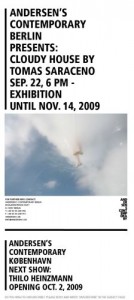






Arndt & Partner Berlin is pleased to present the first solo exhibition by Iranian painter Khosrow Hassanzadeh in Germany. The artist, whose work is currently also on show at the 53rd Venice Biennale, is one of the most prominent representatives of the Iranian art scene today. His fascinating, versatile oeuvre spans a wide range of media from screen-printing, painting and drawing to collages and assemblage. His Berlin exhibition will include work from his latest series Ya Ali Madad (2008-2009) and from his earlier series Terrorist (2004), where screen-printing and painting combine to produce powerful and complex compositions with – as in all the artist’s works – human figures as the focal point.
Arndt Partner

Andersen’s Contemporary in Berlin is very pleased to present Tomas Saraceno’s Cloudy House, an exhibition comprising
a large cloud-installation, sculpture, video, and photographs.
Tomas Saraceno’s experimental works challenge our experience of the built environment. Including balloons and inflat-
able constructions, his sculptures often resemble networks of floating cells or suspended habitats, including airborne
gardens, floating bridges, and large-scale models for futuristic dwellings. Combining visual elegance with rigorous
engineering, Saraceno’s ethereal sculptures re-explore the history of ‘utopian’ modernism while questioning our rela-
tionship to nature and natural phenomena.
With his works Saraceno continues the tradition of visionary architects as Buckminster Fuller, Gyula Kosice, Archigram
and the Ant Farm Collective. His projects often propitiate interrelations and propose an interdependence between
spaces, where the focus is on emphasizing a sustainable and ecological aspect, not only of the rural environments but
also of the social ones.
In his new installation Saraceno takes clouds as a starting point. Clouds and bubbles. Out of matte, white paper Sara-
ceno has constructed light geometrical structures resembling clouds in the sky. Some of the structures are suspended
individually by nylon wires, floating above the viewer’s head. Some have gathered under the ceiling in groups following
the rule of the Weaire–Phelan packing structure, i.e. the rule that bubbles automatically pack together, in such a man- ner that they fill out three-dimensional space in the most efficient way possible and leave the least possible amount of
surface film /material to exist between them.
The form of the bubble is the building block for much of Saraceno’s airborne architecture. Air bubbles contain space and
float on their own, their shape echoes the form of the world. Structurally speaking, as well, they are ideal small-scale
models for his large-scale propositions—as a continuous spherical membrane, the bubble represents a flexible building
component that relies on principles of tension to gain stability.
The work El Mundo visualizes the so-called Bernoulli principle on a transparent inflatable beach ball, depicting a map
of the world. The beach ball is floating free in the air, and attached to the ball is a wireless camera, which transmits
to a video projector, projecting images onto a wall. After a few distracting moments the viewer understands that the
projection on the wall is in fact monitoring real time in that very same room. The camera on the moving beach ball
catches the viewer, who sees herself on the wall upside down, augmenting the perception of a world that has lost its
orbit. The world sometimes falls down or spins too fast but is soon floating again, suggesting the weightless as a new
orbit for the future.
On display is also a series of photographs that – following Saraceno’s practice – suggest a skyscape of the future. For
The Iceland-series, Saraceno travelled to Reykjavijk and set up a huge, transparent, inflatable pillow on the hot waters
of a natural spring. Because of the white steam from the hot spring the participants on top of the see-through pillow,
seem to be lounging and walking in and amongst the clouds.

Another burner from the Skiny:::…

New Stuff from Copenhagen:::…